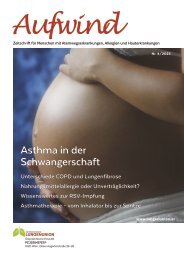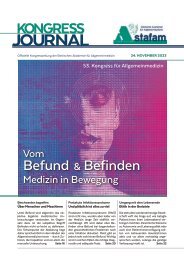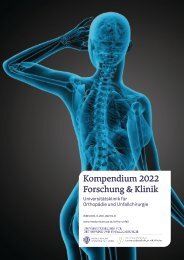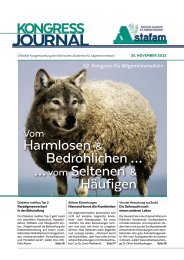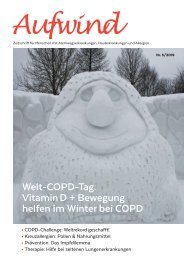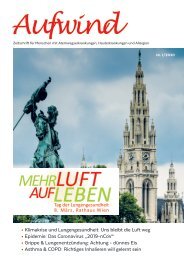Kompendium 2020 Forschung & Klinik
Das Kompendium 2020 der Universitätsklinik für Orthopädie und Unfallchirurgie von MedUni Wien und AKH Wien (o. Univ.-Prof. R. Windhager) stellt einen umfassenden Überblick über die medizinsichen Leistungen und auch die umfangreichen Forschungsfelder dar. Die Veröffentlichungen zeigen die klinische Relevanz und innovative Ansätze der einzelnen Forschungsrichtungen. Herausgeber: Universitätsklinik für Orthopädie und Unfallchirurgie MedUni Wien und AKH Wien Prof. Dr. R. Windhager ISBN 978-3-200-07715-7
Das Kompendium 2020 der Universitätsklinik für Orthopädie und Unfallchirurgie von MedUni Wien und AKH Wien (o. Univ.-Prof. R. Windhager) stellt einen umfassenden Überblick über die medizinsichen Leistungen und auch die umfangreichen Forschungsfelder dar. Die Veröffentlichungen zeigen die klinische Relevanz und innovative Ansätze der einzelnen Forschungsrichtungen.
Herausgeber: Universitätsklinik für Orthopädie und Unfallchirurgie
MedUni Wien und AKH Wien
Prof. Dr. R. Windhager
ISBN 978-3-200-07715-7
Create successful ePaper yourself
Turn your PDF publications into a flip-book with our unique Google optimized e-Paper software.
TOP-Studien<br />
59<br />
Figure 1: Example of a Distal Femur Replacement<br />
due to a low comminuted periprosthetic distal<br />
femur fracture.<br />
p = 0.001). The endoprosthetic systems used in this study are a fixed-hinge type<br />
of prosthesis (Howmedica Modular Replacement System, Kiel, Germany)<br />
and, beginning in 1999, a modified rotating-hinge version of the fixed-hinge<br />
type (Global Modular Replacement System, Stryker, Kalamazoo, MI, USA)A.<br />
Instead of using a Kaplan-Meier analysis, we performed a competing risk<br />
analysis (Fine-Gray model) for the evaluation of incidence of revision surgery<br />
after DFR. Since patients with oncologic conditions and patients undergoing<br />
DFR due to rTKA have a higher mortality rate than the general population,<br />
we defined “death” as a competing event for revision surgery. Competing risk<br />
analyses have proven to be more accurate than Kaplan-Meier calculations<br />
in patients with higher mortality rates because life expectancy might be too<br />
short for experiencing a revision surgery.<br />
Results<br />
The median follow-up duration in the overall cohort was 85 months (range<br />
0.1-391 months). Thirty-two percent (58 of 183) of oncologic patients and<br />
48% (22 of 46) of non-oncologic patients underwent cemented distal femoral<br />
replacement, representing 35% of the overall cohort. During the observation<br />
period, 30% of the patients (69 of 229) died after DFR, 64 of whom were in<br />
the oncologic cohort. According to the International Society of Limb Salvage’s<br />
classification system, complications leading to revision surgery during the<br />
observation period (1983 to 2016) were either soft-tissue failure (Type 1) in<br />
24 patients (16 with oncologic disease), aseptic loosening (Type 2) in 35 patients<br />
(30 with oncologic disease), structural failure (Type 3) in 19 patients (17 with<br />
oncologic disease), infection (Type 4) in 33 patients (27 with oncologic disease),<br />
or tumor progression (Type 5) in five patients.




